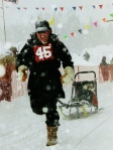Early Dog Sledding Innovations
 The hitching of several dogs to a whalebone or wood toboggan was a significant advancement. The whalebone toboggan of the Bering Sea regions and the narrow wooden toboggan of the Athabascan Indians of the Interior were still in use up until the beginning of the twentieth century. Even today, in the Barter Island region of the Arctic Ocean, one can find Eskimos with primitive toboggans—though they now use modern dog harnesses and the tandem hitch, introduced by the Russians in the middle of the eighteenth century. Up to that time, Eskimos and Indians alike used the ancient, but more natural, fan hitch.
The hitching of several dogs to a whalebone or wood toboggan was a significant advancement. The whalebone toboggan of the Bering Sea regions and the narrow wooden toboggan of the Athabascan Indians of the Interior were still in use up until the beginning of the twentieth century. Even today, in the Barter Island region of the Arctic Ocean, one can find Eskimos with primitive toboggans—though they now use modern dog harnesses and the tandem hitch, introduced by the Russians in the middle of the eighteenth century. Up to that time, Eskimos and Indians alike used the ancient, but more natural, fan hitch.
Another introduction by the Russians was the lead dog—or as it was known until recent times, the foregoer. Traditionally, both Indians and Eskimos had run snowshoes ahead of their dogs with the team following. They believed that they could communicate better with the dogs this way. The modern system of guiding dogs by voice command was also innovated by the Russians.
In the early history of mushing it was considered a disgrace for a dog driver to ride the sled. Although the modern handlebars and foot brake were developed some seventy years ago, the dog driver always stayed just ahead of the sled, while his “swamper” or passenger rode the brake. The dogs were hitched to a long towline, leaving some six to eight feet between the bow of the sled and the wheel dogs. The driver traveled astride the line.
On the right or “gee” side of the sled was the “gee pole”. The gee pole was six or seven feet long and was securely fastened to the sled in a manner that it extended upward and forward, so the driver could rest his right hand on it. Whether running afoot, on snowshoes or on a small toboggan called a “ouija board,” the dog driver stayed in position directly ahead of the sled, steering it down the trail with the aid of the gee pole. The driver used the pole’s leverage to not only steer the sled, but to help keep it upright on slanted trails, break the sled loose when it was frozen in and to hold it back when descending small hills.
Since he had to carry his gear and food for not only himself, but the dogs as well, many drivers in the early days had two or three sleds hooked in tandem. Ben Downing, one the great dog drivers of history, used as many as twenty dogs to pull three sleds. He ran ahead of the lead sled while his “swamper” or dog handler rode the brake on the back sled. Another great dog puncher of the early days, Arthur Walden, carried the mail from Dawson to Nome and ran as many as twenty-seven dogs and three sleds.
___________________
Dr. Robert Forto is the Dog Sledding Examiner, a musher training for his first Iditarod under the Team Ineka banner and the host of the Mush! You Huskies Radio Show







